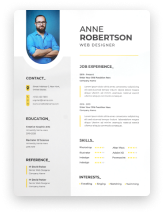In the colorful world of professional painting, your resume is your canvas. This guide is designed to teach you everything you need to know about crafting a resume that not only highlights your skills and experiences but also paints you in the best light possible. Whether you're a seasoned painter looking to brush up your resume or a newcomer ready to dip your bristles into the professional world, we've got you covered.
A Masterpiece Resume for the Aspiring Professional Painter

Professional Painter Resume Sample
Header
MICHAEL ANDERSON
Professional Painter
Email: michael.anderson@paintpros.com
Phone: (555) 123-4567
Location: San Francisco, CA
Professional Summary
Dedicated and creative Professional Painter with over 10 years of experience in residential and commercial painting projects. Expert in surface preparation, color mixing, and application techniques. Known for meticulous attention to detail, exceptional color sense, and ability to deliver projects on time and within budget.
Work Experience
Lead Painter
Golden Gate Painters, San Francisco, CA
April 2016 - Present
- Led a team of 5 painters on various residential and commercial projects, ensuring high-quality finishes and customer satisfaction.
- Developed a project management system that improved team efficiency by 30%.
- Conducted workshops on advanced painting techniques and safety protocols.
Painter
Vivid Colors Painting, Los Angeles, CA
June 2008 - March 2016
- Specialized in interior and exterior painting, achieving a high level of precision in surface preparation and finish.
- Collaborated with interior designers to select and apply color schemes that enhanced the aesthetic appeal of spaces.
- Implemented environmentally friendly painting practices, reducing waste by 25%.
Education
Diploma in Fine Arts
Los Angeles Art School, Los Angeles, CA
Graduated 2008
Certifications
Certified Lead Renovator
Professional Painters Association, 2015
Skills
- Expert in various painting techniques and finishes
- Strong color theory knowledge
- Excellent project management and team leadership skills
- Proficient in using airless sprayers, HVLP systems, and traditional brushes and rollers
- Skilled in surface preparation and minor repair work
Additional Information
- Volunteered as a painter for Habitat for Humanity, contributing to 10+ housing projects.
- Regularly attend professional painting workshops and trade shows to stay updated with the latest trends and technologies.
Crafting the Perfect Structure for Your Painter Resume
When it comes to structuring your professional painter resume, clarity and organization are key. Your resume should be a reflection of your meticulous attention to detail and artistic skill, neatly segmented into sections that guide the reader through your career journey like a well-composed mural. Here's how to lay down the foundation:
Start With a Polished Header
Your header should include your name, professional title (Professional Painter), and contact information (email, phone number, and optionally, your location). This is like framing your canvas, giving the viewer the necessary context before they dive deeper.
John Doe
Professional Painter
johndoe@email.com
(123) 456-7890
New York, NY
The Brushstroke of Your Professional Summary or Objective
This is your chance to capture attention with broad strokes, summarizing your experience, key skills, and what you're looking for in your next role. Tailor this section to match the tone and requirements of the job you're applying for, much like choosing the right palette for a painting.
Skilled and detail-oriented Professional Painter with 5+ years of experience in residential and commercial painting projects. Adept at color matching, surface preparation, and various painting techniques. Seeking a position that allows me to utilize my expertise and contribute to creating visually appealing spaces.
I am a painter looking for a job. I have some experience and I'm good at what I do. Please hire me.
Gallery of Work Experience
Here, detail your previous roles, responsibilities, and accomplishments. Use bullet points to highlight your experience and accomplishments, focusing on outcomes and how you've added value. For instance, discuss the types of projects you've worked on, any specialized techniques you excel in, and any recognition or awards you've received.
Quantify your achievements whenever possible. Instead of simply stating "Improved team efficiency," say "Developed a project management system that improved team efficiency by 30%."
Academic Background and Training
In the education section, list your formal qualifications, including any degrees or certifications relevant to painting and decorating. If you've taken part in workshops or courses on new painting techniques or safety standards, this is the place to mention them.
Showcase of Skills
Your skills section should be a carefully curated collection of your abilities. Include a mix of technical skills (like specific painting techniques or familiarity with materials and tools) and soft skills (such as project management, team leadership, or customer service).
Additional Features to Enhance Your Resume
Consider adding sections for certifications, awards, volunteer work, or projects that can provide a more comprehensive view of your capabilities and character. For example, if you've volunteered your painting services for community projects or participated in art shows, these experiences can add depth and color to your resume.
A Brush with Your Cover Letter
Your resume should always be accompanied by a cover letter, which offers you the space to narrate your professional story more expansively. Think of it as a background layer that adds depth to your resume's composition, allowing you to discuss your passion for painting, your career goals, and why you're a great fit for the role.
Painting Your Career: Crafting an Engaging Resume Summary or Objective
Your resume's summary or objective is akin to the focal point of a painting, where you capture the essence of your professional identity. This section should be a compelling snapshot of your skills, experiences, and career aspirations, tailored to the professional painting role you're applying for.
The Art of a Resume Summary
For seasoned painters with a rich palette of experience, a summary offers the chance to highlight your career highlights and unique talents. This should be a concise, powerful statement that encapsulates your professional journey and what you bring to the table. For example, you might emphasize your years of experience, notable projects, and specific skills that align with the job description.
Crafting an Objective for Emerging Artists
If you're at the beginning of your career or aiming to shift gears into a new aspect of painting, an objective can outline your career goals and what you aim to achieve in the position. It's an opportunity to show your enthusiasm and the fresh perspective you can bring, even if your experience is more limited.
A seasoned professional painter with over a decade of experience in bringing clients' visions to life on both residential and commercial properties. Renowned for meticulous attention to detail, mastery over a broad spectrum of painting techniques, and a keen eye for color and aesthetics. Proven track record of completing projects efficiently, on time, and within budget, ensuring high levels of client satisfaction.
Passionate and dedicated aspiring professional painter seeking to leverage extensive background in fine arts and volunteer painting projects to transition into professional painting. Eager to apply creative talents and strong work ethic to deliver high-quality painting services and exceed client expectations.
Remember, the summary or objective is your chance to make a strong first impression. It should be specific, engaging, and reflective of your professional identity, acting as a teaser that invites potential employers to read on and learn more about your skills and experiences.
Brushing Up Your Work Experience Section
The Work Experience section of your resume is where you detail your professional journey, showcasing the projects you've worked on and the value you've brought to your roles. It's important to structure this section in a way that highlights not just what you've done, but how well you've done it.
How to List Your Painting Experience
For each position you've held, provide a clear title, the name and location of the company, and your dates of employment. Underneath, use bullet points to detail your responsibilities and accomplishments. Focus on quantifiable outcomes where possible, such as the number of projects completed, the size of the teams you've worked with, or any recognition you've received.
Demonstrating Your Impact
Beyond listing tasks, illustrate how you made a difference in your roles. Did you introduce a new technique that improved efficiency? Have you been commended for your exceptional detail work or color matching abilities? These specifics can set you apart from other candidates.
Tailoring Your Experience
Align your work experience with the job you're applying for. Highlight the skills and experiences most relevant to the position, such as specific types of painting projects (residential, commercial, decorative), techniques (faux finishes, stenciling), or leadership roles.
Lead Painter at Creative Coatings, San Diego, CA
2015–2020
- Directed a team of 8 painters in high-profile commercial and residential projects, consistently delivering quality work that led to a 40% increase in repeat business.
- Pioneered a training program in advanced surface preparation techniques, enhancing team skill levels and project outcomes.
- Awarded 'Best Commercial Property Makeover' in 2019 for the transformation of a historic downtown building, showcasing expertise in color theory and application techniques.
Your Work Experience section is the body of your professional story, illustrating your growth, skills, and contributions. By presenting your experiences clearly and compellingly, you can paint a vivid picture of your qualifications and make a strong case for why you're the best candidate for the job.
The Foundation of Success: Education and Professional Development for Painters
In the realm of professional painting, your educational background and ongoing professional development play crucial roles in shaping your career. This section of your resume should not only list your formal education but also highlight any additional training, certifications, or workshops that have honed your skills and kept you abreast of industry standards and innovations.
Highlighting Your Educational Achievements
Start with your highest level of formal education, such as a degree in Fine Arts, which can be particularly relevant for painters looking to showcase a foundation in art theory and practice. If you've completed vocational training specific to painting or decorating, make sure to include this, as it demonstrates a focused commitment to your craft.
Certifications and Continuous Learning
In an industry that values precision and expertise, certifications can significantly bolster your resume. These might include credentials in safety procedures, specialized painting techniques, or leadership training for project management roles. Participation in workshops and seminars not only enriches your skill set but also signals to potential employers your dedication to professional growth.
Diploma in Fine Arts, San Francisco Art Institute, San Francisco, CA
Graduated 2016
Certified Professional Painter, American Coatings Association
Completed 2018
OSHA 30-Hour Construction Safety and Health Training
Completed 2019
Regular attendee of the National Painting and Coatings Expo, keeping up-to-date with the latest industry trends and technologies.
This section is your chance to illustrate the depth and breadth of your qualifications beyond hands-on experience. By showcasing both your foundational education and commitment to ongoing learning, you present yourself as a well-rounded and proactive professional.
Essential Skills for a Professional Painter: Beyond the Brush
The Skills section of your resume offers a snapshot of your capabilities and competencies, both technical and interpersonal. For professional painters, this includes a blend of artistic talent, practical techniques, and soft skills that ensure successful project execution and client satisfaction.
Technical Proficiency
List the specific painting techniques and styles you're proficient in, such as faux finishes, stenciling, or murals. Familiarity with a wide range of materials and equipment, including eco-friendly options, can also set you apart. Don't forget to mention any software skills relevant to project planning and design.
Soft Skills: The Art of Communication and Collaboration
In addition to technical abilities, highlight soft skills such as attention to detail, creativity, time management, and customer service. The ability to work well under pressure and collaborate effectively with clients, designers, and other tradespeople is crucial in ensuring the smooth completion of projects.
- Advanced proficiency in various painting techniques: marbling, graining, and trompe l'oeil.
- Expert color matching and palette selection to create visually appealing environments.
- Skilled in the use of sprayers, rollers, and brushes for efficient and high-quality application.
- Strong project management skills, able to oversee multiple projects simultaneously while maintaining strict deadlines.
- Excellent communication skills, with a proven track record of exceeding client expectations through detailed consultations and clear project updates.
By strategically organizing your Skills section, you provide a clear picture of what you can bring to a painting project or role. This blend of technical know-how and personal attributes is key to demonstrating your value as a professional painter.
Enriching Your Painter Resume with Additional Sections
Beyond the core components of your resume, incorporating additional sections can provide a more comprehensive view of your abilities and character. These extras—like certifications, awards, volunteer experience, or personal projects—can differentiate you from other candidates by showcasing your dedication to your craft and your community.
Certifications: Highlighting Your Expertise
Certifications can significantly enhance your resume by evidencing your commitment to professional standards and ongoing learning. For painters, certifications might include safety training, specialized painting techniques, or project management skills. Listing these certifications shows potential employers that you are serious about maintaining high-quality work and staying updated on industry best practices.
Awards and Recognitions: A Testament to Your Skill
Any awards or recognitions you've received for your painting projects not only add prestige to your resume but also serve as a testament to your skill and creativity. Whether it's an industry award, a commendation from a professional association, or recognition from a community organization, these honors highlight your excellence in the field.
Volunteer Experience: Demonstrating Your Commitment
Volunteer work, especially within relevant community projects, can reflect your passion for your craft and your willingness to contribute beyond paid assignments. This experience can be particularly appealing to employers who value community involvement and social responsibility.
Personal Projects: Showcasing Your Passion
Including personal projects related to painting or artistic endeavors can give employers insight into your passion and creativity. These projects demonstrate your initiative to practice and improve your skills outside of professional mandates, underscoring your dedication to the art and craft of painting.
Certifications:
- Lead Safety for Renovation, Repair, and Painting, EPA Certified, 2020
- Advanced Color Theory Workshop, Color Design Institute, 2021
Awards:
- First Place, Citywide Mural Contest, 'Revitalizing Main Street', 2019
Volunteer Experience:
- Volunteer Painter, Local Schools Beautification Project, Summers 2018-2020
- Art Instructor, Community Center Art Workshops for Youth, 2019-Present
Personal Projects:
- 'Urban Landscapes': A series of cityscape murals exploring the interaction of nature and urban architecture, exhibited at City Art Gallery, 2021.
By thoughtfully selecting and detailing these additional resume sections, you not only provide a fuller picture of your qualifications but also of your personality and values. This holistic approach to resume building can engage potential employers more deeply, making you a memorable candidate.
The Final Touch: Cover Letters and Beyond
A well-crafted cover letter complements your resume by providing context and narrative to your professional journey. It's your opportunity to convey your enthusiasm for the role, highlight key accomplishments, and explain how your skills and experiences align with the company's needs and values.
Tailoring Your Cover Letter
Customize your cover letter for each application, drawing connections between the job description and your background. Use this space to delve into projects or experiences that exemplify your competence and creativity, and explain why you're passionate about the opportunity.
Beyond the Resume and Cover Letter: Preparing for the Interview
While your resume and cover letter are crucial for securing an interview, your preparation for the conversation with potential employers is equally important. Reflect on your experiences, rehearse discussing your projects and achievements, and be ready to share how you can contribute to the company's success.
I am writing to express my interest in the Professional Painter position at Creative Spaces Inc., as advertised on your website. With over 12 years of experience in transforming residential and commercial spaces, I am excited about the opportunity to bring my expertise in color theory, surface preparation, and custom mural design to your team. My portfolio, which includes award-winning murals and high-profile renovation projects, demonstrates my dedication to creating beautiful, enduring work.
In crafting your resume, cover letter, and preparing for interviews, remember that each element is a brushstroke in the larger picture of your professional identity. By thoughtfully assembling these components, you paint a vivid portrait of yourself as a dedicated, skilled, and creative professional painter, ready to contribute to your next employer's success.

Frequently Asked Questions
Q1: How long should a professional painter's resume be?
Ideally, a professional painter's resume should be one to two pages long. It should be concise yet comprehensive, highlighting your most relevant skills, experiences, and accomplishments.
Q2: Should I include a portfolio with my resume?
Yes, it's highly recommended to include a portfolio or a link to your online portfolio when applying for painting positions. A portfolio showcases your best work and allows potential employers to see your skills and style firsthand.
Q3: How should I handle gaps in my employment history?
Be honest about any employment gaps, but focus on the positive. If you took time off to pursue additional training, volunteer, or work on personal projects related to painting, highlight these experiences and how they've contributed to your professional growth.
Q4: Should I include references on my resume?
It's not necessary to include references directly on your resume. Instead, you can state "References available upon request" at the end of your resume. Have a separate list of references ready to provide when asked.
Q5: How can I make my resume stand out?
To make your resume stand out, tailor it to the specific job you're applying for. Use industry keywords, quantify your achievements, and highlight your most relevant skills and experiences. Ensure your resume is visually appealing, easy to read, and error-free.
Q6: What if I don't have formal education in painting?
If you don't have formal education in painting, focus on your practical experience, on-the-job training, and any relevant certifications or workshops you've completed. Emphasize the skills you've developed through hands-on work and showcase your portfolio to demonstrate your abilities.
Q7: How do I choose the right resume format?
The best resume format depends on your level of experience and the type of job you're applying for. Chronological formats work well for painters with a steady work history, while functional or combination formats may be better for those with gaps in their employment or those changing careers.
Q8: Should I include non-painting related jobs on my resume?
Include non-painting related jobs if they showcase transferable skills or if they help explain employment gaps. For example, if you worked in a customer service role, you can highlight your communication and problem-solving skills, which are also valuable in painting.
By addressing these common questions and concerns, you can create a resume that effectively showcases your skills, experience, and value as a professional painter. Remember, your resume is a living document that should evolve as you grow in your career, so don't be afraid to update and refine it regularly.
Recommended Reading









